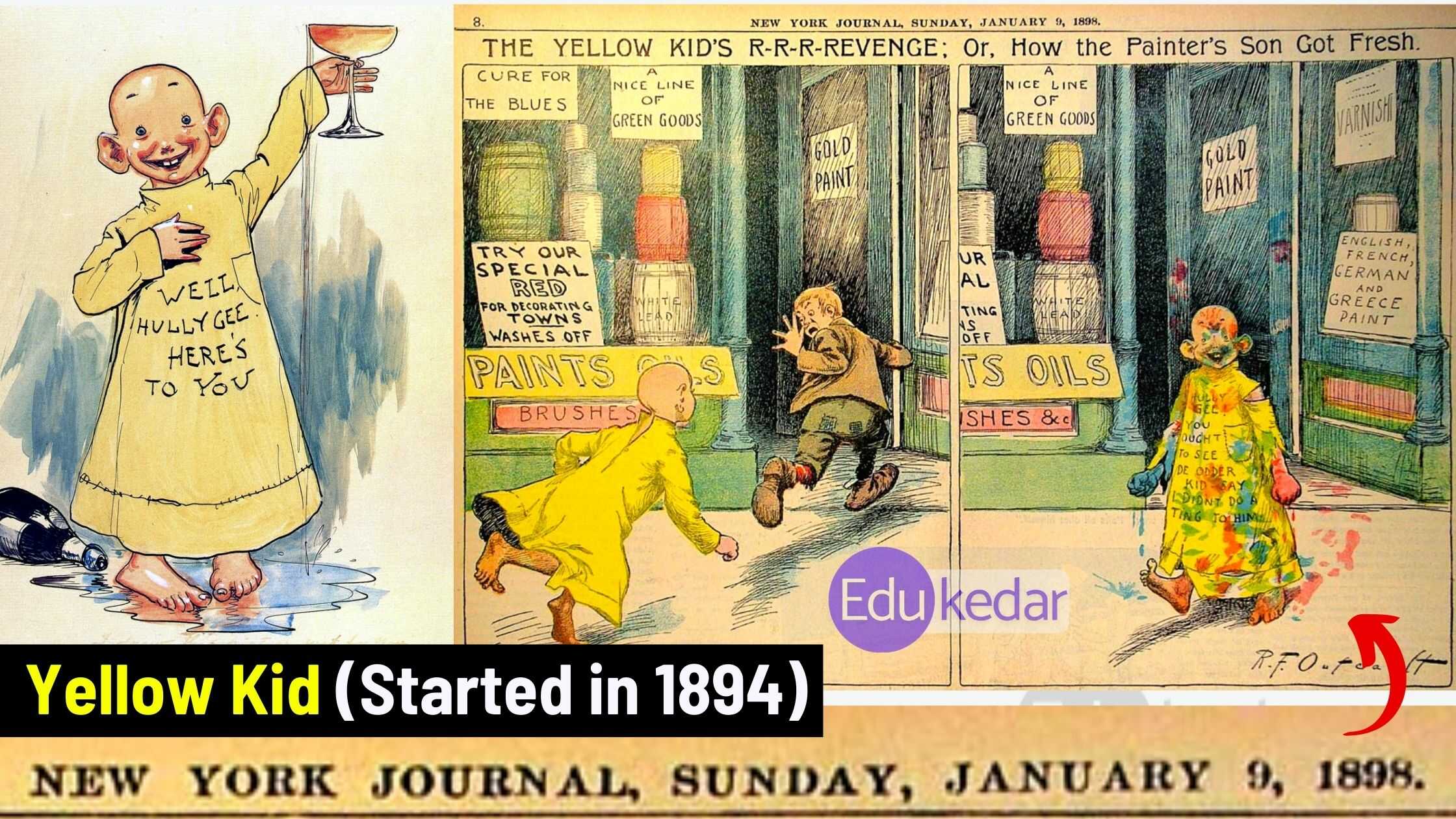Yellow journalism and the yellow press are any journalism that treats news in an unprofessional, unethical, and sensationalized pattern. The techniques utilized in yellow journalism include exaggeration of news stories, events, and various untrue information.
Today we will be discussing the topic What is yellow journalism? Explain in brief. We will also cover all essential aspects of yellow journalism including its Meaning, Definition, history, Characteristics, Impact & Examples.
What is Yellow Journalism?
Yellow Journalism is a form of reporting that is based on sensational stories, clickbait titles, or headlines that were often exaggerated or false information.
Yellow Journalism Meaning
- Yellow Journalism simply means conducting a sensational style of reporting the news to lure readers.
- Yellow journalism refers to biased opinion camouflaged as objective fact.
- It involves sensationalism of news, distorted stories, and misguiding images and information for the sole purpose of increasing newspaper sales, exciting public opinion, and attracting them.
For Example, during the late 19th-century yellow journalism was one of many factors that initiated war between the United States and Spain in Cuba and the Philippines.
Definition of Yellow Journalism
- Yellow Journalism can be defined as a form of reporting that is based upon sensationalism and crude exaggeration.
- Yellow Press or Yellow Journalism presents little or no legitimate well-researched news, and facts and instead uses eye-catching headings to sell more newspapers.
- Yellow press newspapers have several columns and front-page headings about different types of news. such as sports and scandals.
According to Frank Luther Mott, Yellow Journalism can be defined based on five characteristics that are as follows;
- scare headlines in huge print, often of minor news
- lavish use of pictures, or imaginary drawings
- use of faked interviews, misleading headlines, pseudoscience, and a parade of false learning from so-called experts
- emphasis on full-color Sunday supplements, usually with comic strips
- dramatic sympathy with the “underdog” against the system
History of Yellow Journalism
Let’s now discuss the history of yellow journalism and find out where did the term yellow journalism came from?
- The New York World of Joseph Pulitzer began publishing cartoons during 1890s time period. The first very popular cartoon was named “Hogan’s Alley” and it had a character called “The– Yellow Kid”.
- Yellow coloring was not much used (for the first time in a major newspaper to accent the characters).
- The cartoon strip got so popular, that William Randolph Hearst (New York Journal) attempted to replicate it, he even hired the writers of Hogan’s Alley away from Joseph Pulitzer (New York World). This led to direct competition between the two newspapers and Hearst and Pulitzer.
The Yellow Kid

The Yellow Kid Comics in America written by Richard Felton Outcault was based on the life of people living in the slums of New York, which had a character named Yellow Kid.
- It first appeared in the Truth Magazine in 1894.
- It appeared a year later in Pulitzer’s New York World under the name “Hogan’s Alley.” In this Pulitzer used yellow ink to draw attention to the comic.
Joseph Pulitzer and The New York World
He was a Union soldier under Lincoln. He worked for a German newspaper in St. Louis and later became the owner of the St. Louis Dispatch Works tirelessly.
- He developed his skills as the editor of a people’s paper, publishing articles that exposed government, various scams, and business corruption.
- In 1883, with his critical health, he traveled to New York to board a ship for Europe for treatment but refused to leave.
- He did a meeting with a financier and arranged for the purchase of the Newspaper New York World.
- He played a very crucial role in the development of the New York World, he Increased the paper’s circulation from 16,000 to 600,000 people in less than 10 years.
He Wanted newspapers to be champions of human rights and speak for those who did not have a voice (weaker section).
Pulitzer aimed to use the paper to “expose all evil, fraud and scam practices, fight all public evils, misdeeds, and abuses, and to battle for the rights of people with earnest sincerity”.
William Randolph Hearst and The New York Journal
He was the Son of a wealthy politician and Harvard grad. He apprenticed under Joseph Pulitzer at the New York World. His Father gave him the San Francisco Examiner (which
he won in a poker game). At age of 24, Hearst modeled it after the World.
He bought New York Morning Journal 8 years later (1895), and consequently began stealing Pulitzer’s writing staff (Outcault and others), he also hired famous writers (Mark Twain, Stephen Crane) and published sensationalist accounts of the Cuban.
THE CIRCULATION WARS
The Competition between both newspapers leads to irresponsible and unethical journalism. Both men sensationalized events to the extreme, and the public becomes inflamed and angry demanding Congress take to action.
WHEN DID YELLOW JOURNALISM END??
One of the most disturbing and inappropriate features involved with the former practice of yellow journalism is that there is no definite line between this period of yellow journalism and the period afterward.
Does yellow press simply fade away, and will never return? Or it will remain forever?
The answer could be, that it’s not faded, to some extent, it is also currently used by many newspapers and news channels to engage the audience.
We can also say that it will remain with us forever, as the newspapers and news channels need audiences and yellow journalism is an effective tool to attract an audience.
Characteristics of Yellow Journalism
- Scare headlines with excessively large type, in red or black ink.
- Many photos, some of them faked.
- Made up stories, faked interviews, misleading titles.
- Weekly Color Comics. (Sunday Magazines)
- Campaigns for those who suffered abuse.
- Use of Emotional Words and images
- Propaganda to create buzz
- PR stunts and dramatic events
- Highlighting negative or bad news.
- Showing victims to increase audience
Some other characteristics of yellow journalism are stated below:
- The use of multicolumn headlines, oversized pictures, bold colors, and dominant graphics.
- Self-promotion within the news medium to increase the audience of a particular newspaper or news channel.
There are a certain set of topics that were given preference based on the interest of the audience always, topics like politics, war, international diplomacy, entertainment, and sports were generally given a front-page placement to make them more attractive and appealing.
The journalists and publishers always tried to make an attractive layout. Sometimes, page number one would only have a single piece of article to grab readers’ attention more. Along with the layout and article, they emphasized using different illustrations.
- This type of news usually did not have any verified source.
Impact of Yellow Journalism
The effects of yellow journalism are the emergence of a very inappropriate culture of sensationalism, social, political, and economic changes in life, as well as distorted mass media.
Yellow Journalism is seen to come into the picture whenever the competition between media arises. In today’s world, as we have advanced and started using modern methods and technologies. Even technology has not been able to change the principles and essence of Yellow Journalism.
Impact of Yellow Journalism on Society
- Sensationalization of cultural norms
- Persuade politics interest
- Gender Discrimination
- It creates fear in public.
- Conflicts: Human security issues and country security issues
- Mass Media and Interest of Public: Norms and various Ethics of Media
- The danger to the credibility of Mass Media and Democracy
- Media Change and Social Change- Promoting Violent Behaviour and irrelevant practices
- Yellow journalism increases readers and sales in unethical ways.
Must Read :What is Business Ethics?
Examples of Yellow Journalism
There are many examples of yellow journalism and a few of them are as follows;
Yellow Kid – a popular comic strip character
The yellow kid is a popular comic strip character printed by both papers (New York Journal and New York World) in the 1890s when this circulation battle was in full swing. thus the term “yellow journalism” originated.
The yellow kid was the first famous cartoon drawn by Richard Outcault for Joseph Pulitzer’s World. It was a little boy dressed in a yellow nightshirt that would comment on happenings in the city. People would buy the World just to read the yellow kid.
Cuban Revolution – “Journalism of action”
Frederick Remington, a painter, and illustrator told Hearst that there is no war to cover in Cuba, and Hearst replied: “You furnish the pictures. I’ll furnish the war.”
There was supposedly a rebellion by the Cuban people against the Spanish that ran the country. To sell the newspapers both Hearst and Pulitzer had their reporters to stretch the truth to increase their readers.
Fake stories were run about women and children being killed and threatened by the Spanish, people starving on the streets, etc.
Spanish-American War
Yellow journalism helped to push war between Spain and the United States in 1988. The USS Maine, a US battleship, sunk from an explosion.
Joseph Pulitzer and William Randolph Hearst published false articles about a plot to sink the ship, thereby increasing tensions. While not a part of the decision directly, the two men (Pulitzer and Hearst) are blamed by many historians for drawing the United States into the war.
“Fake news” appeared for the first time in America, and leaves readers wondering whether journalists care more about selling copies and earning money or to report the exact truth.
Clickbait (Modern day Yellow Journalism)
Clickbait is a modern form of yellow journalism that is widely popular all over the internet sites i.e. YouTube, Facebook, Instagram, and all other social media platforms.
Clickbait is a title text or a thumbnail link that is designed to attract viewers and entice users to follow that link and read view, or click on the linked piece of online content, being typically deceptive, sensationalized, or otherwise misleading.
Most of the time thumbnail images are so catchy and deceptive in nature and don’t present in the actual video. it is purely decorative and designed to grab the attention of the users.





